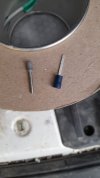Boot-lace ferrules. Those are sweet if you have them. I must confess to just tinning the ends of my stranded wire to get the same basic end as a boot-lace ferrule. But then, sometimes it's just too big for those type of connector openings. I have squeezed them in pliers to make them more square to fit the opening. I have filed them slightly for the same problem. I have also, in a pinch taken a spade connector (those u shaped crimp on things), crimped it to the wire, and then cut off one leg (if the amperage was low) or folded both legs together to get a slightly smaller square end (similar to filing the round tinned wire to a square profile). Of course, any reduction in the wire size at the end of your wire will reduce its amps capacity. But, if the connector won't take it anyhow, maybe it was not intended for 12 gauge wire in the first place?
This brings us to the "It's time to look up some specs" portion of our program. The Digitrax EVOXD with its DCS 210+ shows a rating of:
- 5 amps of power with included PS615 power supply
- 8 amps with PS2012E power supply (sold separately)
So, even if you spring for the bigger power supply, It seems that you will be outputting 8 amps at the max setting. I am not an electrician, but my friends who are (and you can look this up to confirm it) tell me that when doing house wiring, code requires 12 gauge wire for
20 amp circuits and 14 gauge wire for
15 amp circuits. Your potential is
8 amps. I don't know how far it is from the house to your railroad, but it is quite a few feet from my electrical panel to the other end of my house. Of course, we are talking about 120 volts of AC power in that example.
More important to our situation may be voltage loss at a certain amount of amps, volts, distance. The second link here show a voltage drop of just a couple of volts at 8 amps, 24 volts, 100 feet for a pair of 14 gauge wires. And that is with a LOAD of 8 amps. At a load of 2 amps you only loose a half a volt.
A wire length calculator:
A voltage drop calculator:
This free voltage drop calculator estimates the voltage drop of an electrical circuit based on the wire size, distance, and anticipated load current.

www.calculator.net
BUT....all that being said, we could use some practical experience opinions here. What do you all use at what footage to how many connections on your empires? I have been digging on Greg's site but have not found wire size at distance recommendations there...yet....
ALSO....a thought

......if you run a piece of track into your house, or very near your house, then your feeders don't have to go very far and your "wire gauge" for the rest of the railroad is whatever the rail size and type is....right?






